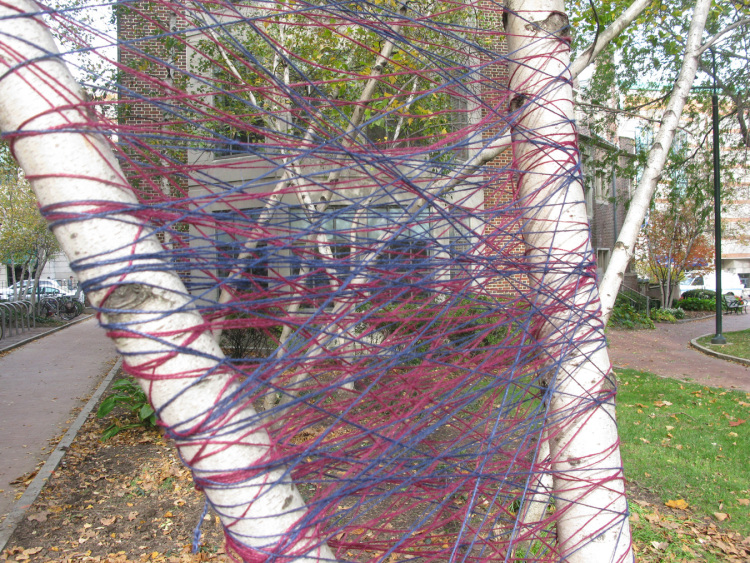If you happened to stroll through campus during Homecoming Weekend — or any of the first 10 days of November, for that matter — you might have noticed some red and blue string wrapped around a naked tree. Or a fence. Or even a frat house column.
That would be the work of Robert Dimin, who received an Arts Year Grant to fund his campus-wide installation String Theory. A first-year MFA student in Combined Media, Dimin has been using string to create public art installations since 2007, when he wrapped a group of trees behind the Princeton, N.J. Institute for Advanced Study with neon pink mason’s twine. “I selected the material because of [artists Fred] Sandback and [Marcel] Duchamp,” he says, “but I took it a step further [by using] a traditional mason’s material to talk about traditions and the history of sculpture.”
He’s been wrapping and placing string around the world ever since — from the base of the Athenian Acropolis to the rocks of Malibu Beach.
“I would leave these installations out for a few weeks at a time, photograph them and take them down,” Dimin says. In May of 2008, CVZ Contemporary art gallery in New York City showcased his string work in an exhibition. The show included branches covered with string and projected images of the string sculptures he had already created. Later that year, he was selected to participate in the Vienna Biennial, and wrapped part of the historic Wiener Künstlerhaus art museum in string.
To create String Theory at Penn, Dimin traded his usual neon-pink twine for Quaker red and blue, using 30,000 feet of string to wrap permanent fixtures from the Fisher Fine Arts Library to the Kelly Writers House.
In an attempt to bolster community spirit, he reached out to both graduate and undergraduate students to assist in the installation process. “My hope is for every member of the university community, as well as many of the alumni and visitors to the campus, to have the opportunity to view at least one of the works,” Dimin wrote in his initial grant proposal. In addition, the choice of red and blue string, “will allow all of those who participate to feel this pride for our university as well as towards art.”
Applications for the second round of Arts Year Grants — just one component of the University’s Arts & the City Year initiative — are due Feb. 1, and I look forward to seeing the next batch of arts-related projects that receive funding.
As for Dimin’s future endeavors, “What matters to me in my work is exploring new materials, having some level of sustainability or discussing concerns of our environment, and speaking to political and social issues of our time,” he says. “How the work is manifested next, I can’t really say, because I am unsure. I’ve been enjoying using recycled tires as of late…[and] I’ve also been placing myself in my works, realizing that the string installations are, in some sense, performances.”


